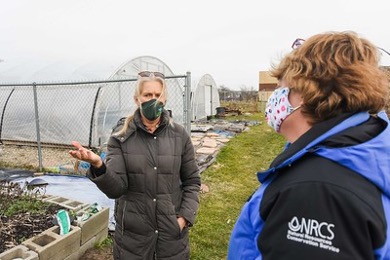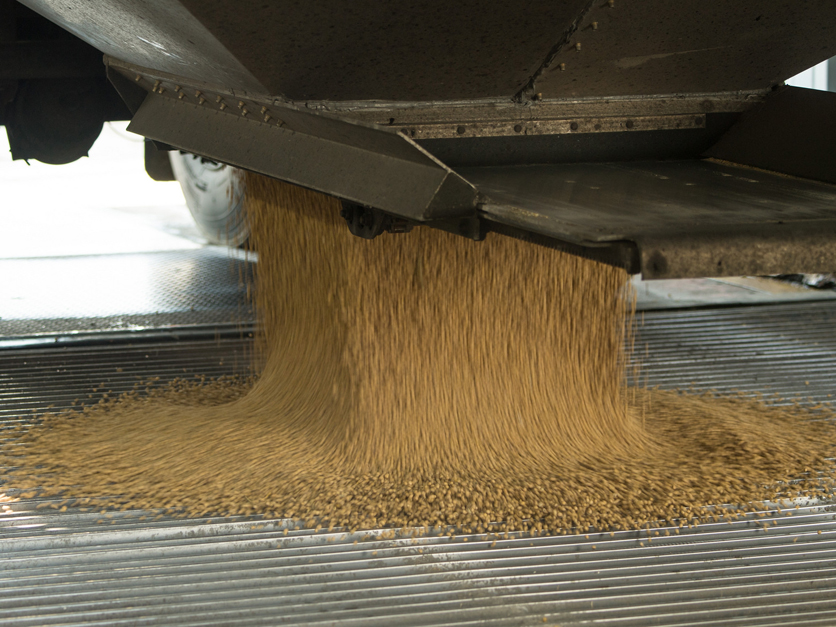Robert Bonnie, USDA’s undersecretary for farm production and conservation, says the Farm Service Agency and Natural Resources Conservation Service are staffing up field offices as fast as possible as COVID infection rates drop.
In an interview with Agri-Pulse, Bonnie said 800 of 2,800 field offices went from 25% to 50% staffed this week because of falling infection counts. FSA and NRCS have been adjusting the staffing levels at the beginning of each week, but he says the agencies may be making changes more frequently going forward.
“The good news is we can go really quickly as soon as data changes,” he said.

NRCS staffer in the field in 2020.
Bonnie: Early adopters to be protected in climate projects
Bonnie says the $1 billion in climate projects the department will fund this year will benefit agriculture across the country as well as farms of all sizes. “We want to have a portfolio at the end of the day that covers a broad suite of crops, livestock, forestry, producer types,” he said.
Some projects could scale up existing programs, while others may be brand new, such as developing a climate-smart beef product for a local market.
For now, the administration is steering away from using the projects to develop standards that could then be used in labeling or registering low-carbon products. USDA raised product labeling as a potential goal when it solicited input on the initiative last year, and Ag Secretary Tom Vilsack talked up the idea of green labeling while attending the COP26 global climate conference in Glasgow last November.
“We're sensitive to the fact that if USDA came out of the gate said, ‘Hey, we're gonna do a standard,’ it would feel very, sort of top-down to producers,” Bonnie said. Still, he said the information gleaned from the projects on measuring and monitoring the impact of climate-related practices could someday lead to the development of USDA standards.
Take note: USDA has announced a second year of crop insurance premium subsidies for farmers who plant cover crops. Farmers have until March 15 to report their cover crop acreage to the Farm Service Agency. 
US soy trade finishes strong in January
Brazil’s soybean harvest is chugging along – albeit somewhat delayed and weaker than expected. But U.S. soybean export sales of old crop and new crop beans remained robust in the last week of January, according to the latest data out of USDA.
USDA’s Foreign Agricultural Service reports export sales of U.S. soybeans for delivery in the 2021-22 marketing year in the week of Jan. 28-Feb. 3 totaled about 1.6 million metric tons – a 46% increase from the previous week and an 81% increase over the previous four-week average. FAS also reported export sales of 894,600 tons for delivery in 2022-23, which begins Sept. 1.
Physical U.S. exports for the week were also strong. FAS says the U.S. shipped 1.3 million tons overseas with most of the shipments going to China.
Take note: While Brazilian soybeans are starting to hit the market, prices are high enough there to make old crop U.S. soy competitive, says Mac Marshall, vice president of market intelligence at the United Soybean Board and U.S. Soybean Export Council.
US fishing complaints could spark new trade spat
The Biden administration’s pressure on Mexico to improve its protection of an endangered porpoise in the Gulf of California has the potential to evolve into a new trade spat with Mexico, the second largest foreign market for U.S. ag exports and the largest importer of U.S. dairy.
The Office of the U.S. Trade Representative says it’s seeking environmental consultations with Mexico under the U.S.-Mexico-Canada Agreement to address Mexico’s failure to protect “the critically endangered vaquita porpoise, the prevention of illegal fishing, and trafficking of totoaba fish.”
The talks would be technical in nature, but could result in the U.S. eventually demanding a dispute panel and that could then result in U.S. punitive measures, according to a senior USTR official. The official stressed that while it’s premature to discuss any type of dispute settlement action, it would be “on the table.”
Ukraine on track for record wheat exports
Wheat trade may not be the top concern for Ukrainians who are facing down the rising presence of Russian troops on their border, but Ukraine’s farmers are still benefitting from very strong exports, according to a new FAS analysis. Russia is Ukraine’s biggest competitor for wheat trade, but lower Ukrainian prices are giving the country’s farmers an edge on the international market.
FAS has shaved its forecast for Ukrainian wheat exports this year, but the country is still expected to make record shipments of about 24 million tons of the grain.
“Ukraine harvested a record crop of 33 million tons and has followed its typical pattern of strong exports in the first half of the year,” FAS said. “Exports are usually brisk in the first few months given the limited storage infrastructure and the pressure to ship other grains, especially corn, later in the season.”
She said it. “Even as the economy begins to open back up, increased demand on the food supply chain and resulting inflation means, unfortunately, that consumers will likely continue to see some short-term grocery price increases for the next several months.” – Leslie Sarasin, president and CEO of FMI – The Food Industry Association, which represents major supermarket chains.
Grocery prices rose 1% in January and are up 7.4% over the past 12 months, the government reported Thursday.
Send questions, comments and tips to philip@agri-pulse.com.



